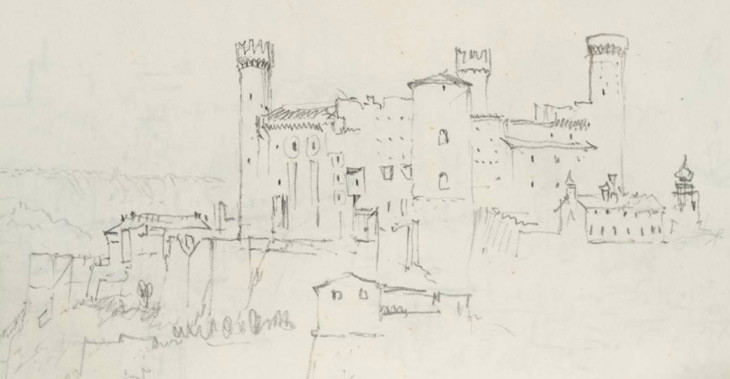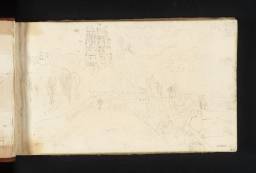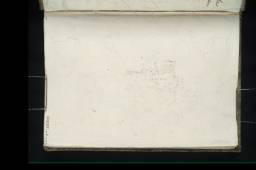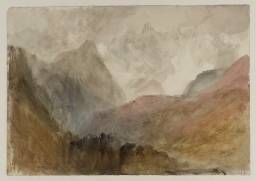Tour to the Alps 1836

From the entry
The sketches in the two sketchbooks and numerous separate sheets catalogued here were mostly made in 1836 on a tour to the Alps. Turner travelled in the company of a wealthy Scottish landowner, Hugh Andrew Johnstone Munro of Novar. Apart from Turner’s sketches, Munro’s recollections of the tour are the most important source of documentation for the tour. These were set out in two letters written to John Ruskin in 1857 (Ruskin Library, University of Lancaster), and in testimony given to Turner’s biographer Walter Thornbury, probably at about the same time, that formed the basis of the account given in Thornbury’s Life of Turner when published in 1862. These sources are given in full in the most complete account of the tour to date, that by the present writer for the exhibition in Aosta in 2000. Munro’s testimony fixes the year of his tour with Turner as 1836 and the basic order of the itinerary. He relates that they crossed the Channel from Dover and then went to St ...
Val d’Aosta sketchbook, principally 1836
D29032–D29108; D29110–D29212; D41094–D41097; D41202
Turner Bequest CCXCIII
D29032–D29108; D29110–D29212; D41094–D41097; D41202
Turner Bequest CCXCIII
Fort Bard sketchbook 1836
D29213–D29237; D29239–D29264; D29266–D29273; D29275–D29377; D41206–D41208
Turner Bequest CCXCIV
D29213–D29237; D29239–D29264; D29266–D29273; D29275–D29377; D41206–D41208
Turner Bequest CCXCIV
Loose sheets associated with the tour c.1836
D25381, D25384, D25385, D25439, D25444, D34185, D34186, D40346, D34188, D34195, D34277–D34291, D34507, D34508, D34513, D34514, D34881–D34883, D34888–D34890, D34894–D34896, D34898, D34906, D34907, D34916, D35879, D35887, D35891, D35892, D35936, D35964, D35971, D35974, D35979, D35996, D36058, D36083, D36109, D36175, D36176, D36212, D36223, D36226, D36230, D36236, D36240, D36267, D36269
Turner Bequest CCLXIII 258, 261, 262, 316, 321, CCCXLII 1, 2, 4, 11, 75–86, CCCXLIV 144, 144v, 149, 150, 389–391, 394–396, 400–402, 404, 412, 413, 421, CCCLXIV 40, 47, 51, 51v, 93, 121, 128, 131, 136, 152, 212, 237, 262, 317, 318 351, 361, 364, 368, 374, 377, 399, 401
D25381, D25384, D25385, D25439, D25444, D34185, D34186, D40346, D34188, D34195, D34277–D34291, D34507, D34508, D34513, D34514, D34881–D34883, D34888–D34890, D34894–D34896, D34898, D34906, D34907, D34916, D35879, D35887, D35891, D35892, D35936, D35964, D35971, D35974, D35979, D35996, D36058, D36083, D36109, D36175, D36176, D36212, D36223, D36226, D36230, D36236, D36240, D36267, D36269
Turner Bequest CCLXIII 258, 261, 262, 316, 321, CCCXLII 1, 2, 4, 11, 75–86, CCCXLIV 144, 144v, 149, 150, 389–391, 394–396, 400–402, 404, 412, 413, 421, CCCLXIV 40, 47, 51, 51v, 93, 121, 128, 131, 136, 152, 212, 237, 262, 317, 318 351, 361, 364, 368, 374, 377, 399, 401
References
The sketches in the two sketchbooks and numerous separate sheets catalogued here were mostly made in 1836 on a tour to the Alps. Turner travelled in the company of a wealthy Scottish landowner, Hugh Andrew Johnstone Munro of Novar.1 Apart from Turner’s sketches, Munro’s recollections of the tour are the most important source of documentation for the tour. These were set out in two letters written to John Ruskin in 1857 (Ruskin Library, University of Lancaster),2 and in testimony given to Turner’s biographer Walter Thornbury, probably at about the same time, that formed the basis of the account given in Thornbury’s Life of Turner when published in 1862. 3 These sources are given in full in the most complete account of the tour to date, that by the present writer for the exhibition in Aosta in 2000.4
Munro’s testimony fixes the year of his tour with Turner as 1836 and the basic order of the itinerary. He relates that they crossed the Channel from Dover and then went to St Omer. Turner took with him the Val d’Aosta sketchbook, which he had used previously on a trip to Stratford-upon-Avon probably in 1833 to make sketches of Shakespeare’s Monument in connection with his illustrations to the works of Sir Walter Scott. On that visit he had filled about twenty pages of the sketchbook but about 70 remained untouched.
Munro explained that at the outset of the 1836 tour Turner was anxious to take in a number of sites in France that he had not sketched before, particularly the small town of Ham5 a few miles south-west of St Quentin. The itinerary discoverable from the Val d’Aosta sketchbook includes subjects at St Omer, Bethune, Arras, Peronne, Ham, Laon, Reims, Chalons-sur- Marne, Vitry-le-François, St Dizier, Chaumont and Langres to Dijon. At Dijon, Munro recorded that Turner was ‘anxious to find something better than Harding had found’.6
After that the two travellers continued via Dole to Lake Geneva, which it appears they toured partly by steamer and partly by road, taking in Lausanne, Vevey, Montreux, Chillon, Villeneuve, St Gingolph and Meillerie, finishing at Geneva itself where Turner made a comprehensive survey of the River Rhône down to its nearby junction with the River Arve. Munro described Turner making a sketch hereabouts on the back of one of his own, but later when Munro looked for it in the Turner Bequest, he could not find it.7 The two men then followed the Arve Valley up to Chamonix. Munro remembered Turner giving him an impromptu sketching lesson at Sallanches,8 and the artist valuing very highly his sketches of Mont Blanc. After Chamonix they took the Col du Bonhomme route around Mont Blanc to Courmayeur and the Val d’Aosta, probably the highlight of the tour.
As Turner worked his way down the valley towards the city of Aosta it appears that he began to run out of space in the Val d’Aosta sketchbook and squeezed sketches into every available space. The subjects in the Fort Bard sketchbook begin at Aosta, so it looks very likely that the sketchbook was bought there. At Aosta Munro recalled Turner becoming frustrated with a watercolour sketch that he was making, and on another occasion the artist commented that he could do far more work in pencil in the time it took to sketch in watercolour. Munro remembered that Turner routinely used a sponge as part of his watercolour procedure. Although Munro could not remember watercolour coming into use until they arrived at Lake Geneva, his comments are important evidence that working in watercolour was an important part of the tour besides the pencil sketches Turner made in his sketchbooks and on loose sheets. Quite a number of watercolours survive in scattered collections, and related examples are noted in the entries for corresponding subjects in the Tate sketchbooks. Munro says they travelled together as far as Turin (of which however there is no evidence in the sketchbooks) ‘where he returned via the Rhine and left me’. The implication is that Turner travelled on from Turin without Munro. The sketches suggest an itinerary from Turin via Susa to the Mont Cenis Pass, down the Maurienne Valley to Chambéry, but there are no identifiable sketches beyond Chambéry amongst this material.
Apart from the numerous watercolour studies, which according to Munro’s testimony appear to have been made, or at least partly made direct from nature, in this writer’s opinion only one oil painting, Snow-storm, Avalanche and Inundation – a Scene in the Upper Part of Val’Aouste, Piedmont (Art Institute of Chicago)9 exhibited at the Royal Academy in 1837, resulted from this tour.
Note: the subsection of loose sheets associated with this tour has been added by Elizabeth Jacklin without otherwise affecting the text of this introduction by David Hill.
Walter Thornbury, The Life of J.M.W. Turner, R.A. Founded on Letters and Papers Furnished by his Friends and Fellow-Academicians, London 1862 [1861], vol.1, pp.229–31.
Ruskin Library MSS 54E, quoted by Hill 2000, p.262. Munro calls Ham ‘La Pucelle’. Meaning ‘The Maid’ this refers to Joan of Arc, who spent time in the castle at Ham.
In 1836 James Duffield Harding (1798–1863) published a series of fifty lithographs, Sketches at Home and Abroad, including one of Dijon dated 1 October 1834. As a spur to his efforts in the city Turner visited the exact viewpoint of Harding’s plate; see the Val d’Aosta sketchbook (Tate D29145; Turner Bequest CCXCIII 58a).
Munro told Ruskin that there was another case of Turner drawing on the verso of one of his own sketches, but did not specify the subject. It is intriguing to think that there were evidently some 1836 sheets with a sketch by Munro on one side, and one by Turner on the other, but sadly no such instances have yet been identified.
Turner made four sketches in Munro’s ‘block’, which Munro said he kept (despite Thornbury slightly twisting his story, see Hill 2000, p.263), but again sadly there is no record of these having come to light afterwards.
How to cite
David Hill and Elizabeth Jacklin, ‘Tour to the Alps 1836’, August 2019, in David Blayney Brown (ed.), J.M.W. Turner: Sketchbooks, Drawings and Watercolours, Tate Research Publication, February 2014, https://www



